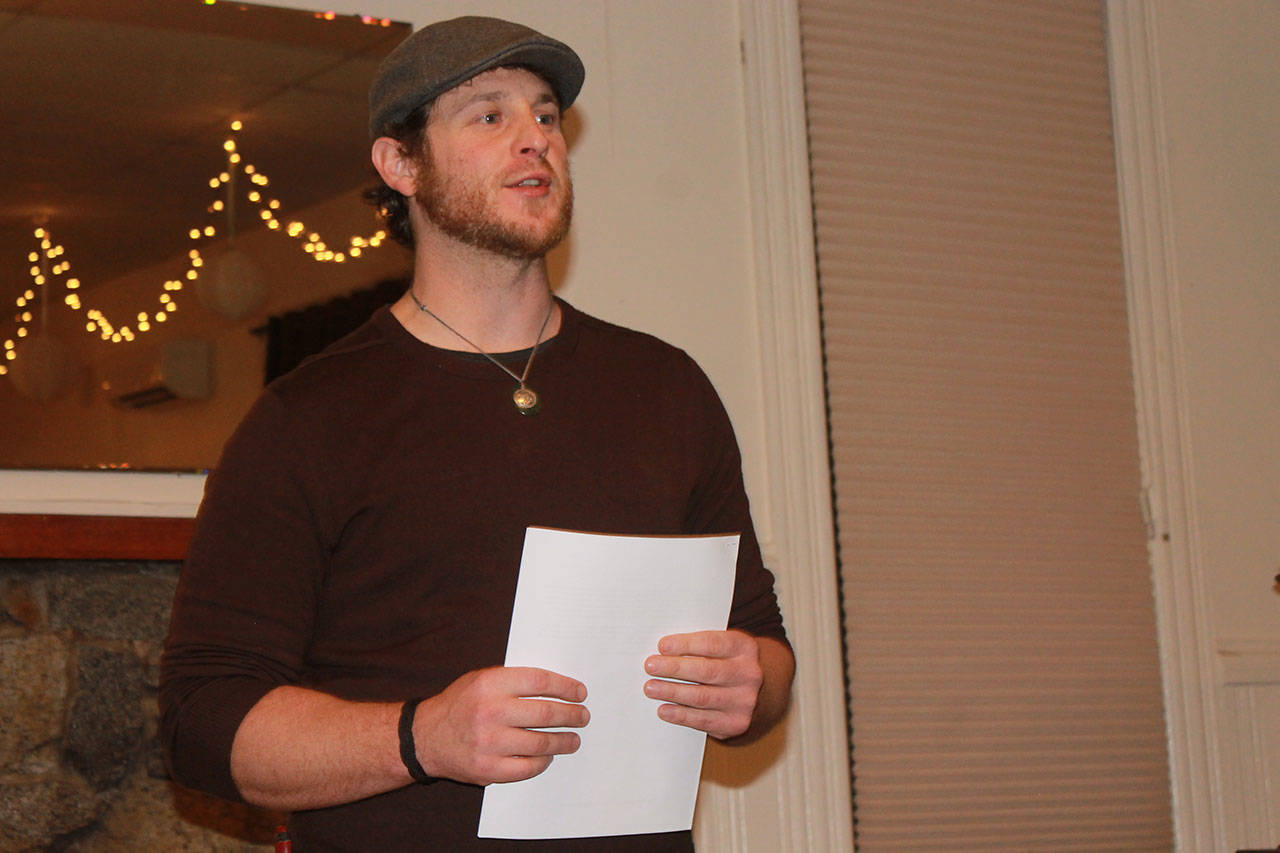After recovering from 50 mph winds on Nov. 26 and 27, causing county-wide power outages, islanders packed the San Juan Island Grange to learn about preparing for natural disasters, including massive storms.
“I don’t think it is a good thing to do this [prepare] out of fear,” said Nathan Donnelly, a Lopez-based survivalist skill instructor. Donnelly was one of four presenters at the Nov. 28 event about personal and community preparation for disasters most likely to hit the San Juans. Brendan Cowan, director of San Juan County’s Department of Emergency Management, and local Red Cross representatives Laura Jo and Bill Severson also spoke.
“Imagine if you spent all your time thinking about and planning for something that only happens every 300 years. That is my job,” Cowan said explaining his position at the county’s Department of Emergency Management.
He has worked with many other emergency agencies around the country, including the Federal Emergency Management Agency.Cowan said he has seen communities impacted by fires, floods and hurricanes and said he is always struck by the human compassion that shines through the loss, heartache and chaos.
“For every person who is severely impacted, there are hundreds to thousands more who roll up their sleeves and help,” said Cowen.
He reviewed a few top local disaster concerns; fires, earthquakes and tsunamis. The fact that the county is surrounded by water keeps the possibility of rampant wildfire down.
“Fire is an issue, but it’s rare,” Cowan said.
Earthquakes and tsunamis in the Pacific Northwest stem from the Cascadia subduction zone running along the coast of California into Canada. The zone has the potential to produce a magnitude nine earthquake, with a tsunami on the side. The good news, Cowan said, is that the islands are bedrock, and according to models, massive wave surges throughout the county are unlikely. A draft tsunami inundation area map posted on the DEM website, for example, shows wave surges reach no higher than two to four feet along most shorelines. Water may rise around 14 feet in locations on the south end of Lopez, Decatur and Eastsound.
“People ask me if there is a warning for a tsunami, I tell them here is your warning, you fell down because the earthquake was so strong,” Cowan said.
While San Juan County will probably be better off than the mainland, help from FEMA or the American Red Cross will help dense populations like Seattle, Portland or Bellingham first. Cowan warned islanders to be prepared to be on their own, without power or running water for about two weeks. Those with prescription medications should have a 90-day supply on hand, he said, also encouraging people to get to know their neighbors.
“Schedule a meeting once a year, that’s all it takes,” Cowan said, adding he is available to speak at neighborhood meetings to help islanders prepare for a disaster together.
Donnelly added that powerful storms – especially as the effects of global warming increase – are probably the most likely of all the events to occur first.
“The good news is these islands are hardened to storms. I work in construction and the trees here are far denser than on the mainland,” Donnelly said, continuing that he noticed storms that caused little damage locally, destroyed trees elsewhere like toothpicks. “Whatever you have seen in Hollywood disaster movies, forget it.”
His advice to people is to become a resource rather than a liability, which means having a level of preparedness beyond stockpiling food.
“Sitting on top of a bunch of canned goods isn’t going to work. You will end up being a skeleton,” Donnelly said.
Everyone, he continued, has a skill and role to play.
“Even grandparents. If you’re a grandparent and can calm a room full of kids, hey that is important,” he said.
He added that people should imagine situations that may arise, and what could be done to be a step ahead. Consider all the critical needs for survival; food, water, air, sleep even basic hygiene.
“Humans’ greatest asset is our abstract thinking,” he noted.
Donnelly’s tips include storing shoes by the bed with a flashlight; filling a bag with clothes, food, utensils, and water; and learning to sanitize water in a variety of ways, like boiling and using chemicals. Having a gun could be helpful, as long as the user has proper training, he said.
An audience member asked how long canned goods last and Donnelly explained that temperature fluctuations can damage them; storing them in the house, in a low cupboard is best.
Another asked whether islanders should try to save boats after a large earthquake.
“Don’t go near the water,” Cowan replied. No one is sure how high a tsunami wave may rise until the actual event occurs, he added explaining that there is still a lot to be learned about earthquakes and tsunamis.
The crowd also questioned whether they should try to get outside in the case of an earthquake.
“You won’t be able to move if it is the big one, and it is usually advised just to stay where you’re at. But if you can and feel you would be safer outside, do it. Common sense should always prevail,” Cowan said.
Loss among the San Juans’ low population would be easily felt, noted Donnelly.
“What if like 12 people died at once on Lopez?” he asked. “I don’t think we have ever lost that many people at one time. It would be very difficult for the community.”
However, with a population around 17,000 supporting hundreds of nonprofits, Cowan said the county would rally together.
“What I have seen, small tight-knit communities respond better, recover faster,” he said.
For more information, visit joomla.sanjuandem.net.



